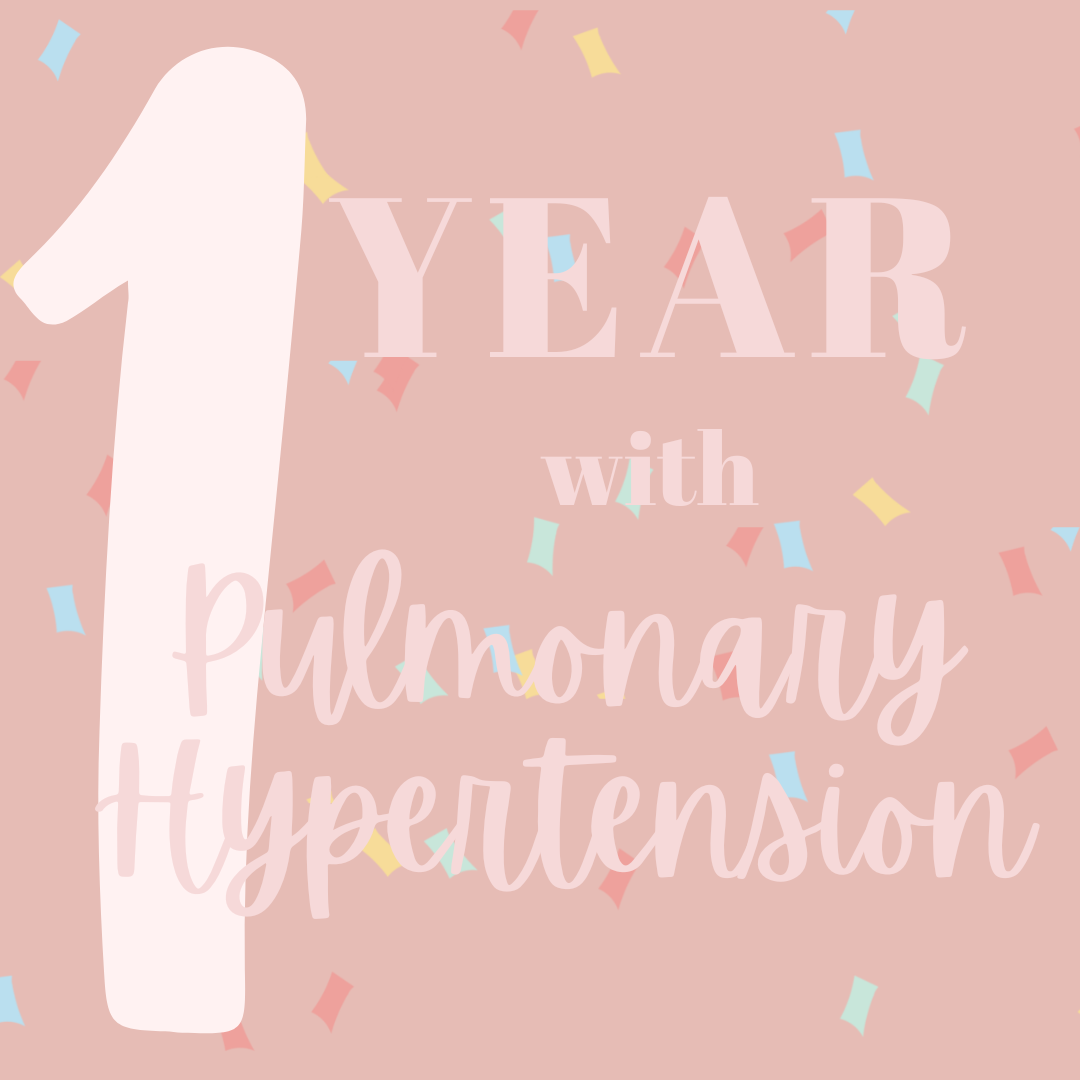September is CTEPH and FSGS diagnosis month. Honestly, it is really hard to believe it has been one year. All too often with chronic illnesses, it takes weeks, months, and even years to finally get a diagnosis. However, that is just the beginning of the road.
Sit Down and Grab A Glass of Wine
I was first introduced to CTEPH (chronic thromboembolic pulmonary hypertension) while incredibly miserable and dependent in the ICU. If you are new here, I’ll try my best to give you the abbreviated version. I was admitted to the hospital with a large pulmonary embolism 24 hours before Hurricane Ida hit New Orleans, and subsequently the hospital I was admitted to. Fast forward a few days, I was struggling and my body was trying its best to keep homeostasis. One night while still admitted, I felt incredibly sick and my blood pressure dropped to a dangerously low level. I was ultimately admitted to ICU until I could become more stable.
Throughout my whole stay, I was miserably swollen everywhere, legs, arms, abdomen, you name it. I couldn’t even get out of the bed to go to the bathroom without extreme exertion and reduced oxygen saturation. The hospitalist told me I had to be off the oxygen to be able to go home. I could have cried, because I was already pushing 4L and I felt like I was going to live in that tiny jail cell of an ICU for weeks.

Being admitted to the hospital is the ABSOLUTE WORST experience ever. You are already there because you are feeling miserable. You are out of your comfort zone without your favorite hygiene products, pillow, or necessities. I needed help with pretty much every single task, except eating. Even that I didn’t feel like doing. It was rough. I was admitted twice within the past year. Once for 8 days, and once for thankfully just 1 night of observation. I hope to keep it that way for a while..
CTEPH? I’m Sorry, What?!
Anyways, I was in this miserable ICU room and two pulmonologists come to my bedside to explain what they thought was going on with me. Much to my surprise, they told me after reviewing my medical records they had detected another pulmonary embolism that had gone undiagnosed just one month prior. My hematologist always orders a CTA (chest CT with contrast) prior to any medical procedure I have to make sure I don’t have any clots. Well this was a chronic one that was not detected by the radiologist reading the report that day.
They then begin to describe CTEPH and tell me that my heart is under strain. My body has been likely making clots for months without me even knowing. I honestly don’t even remember what she told me that day, because I was in SHOCK. At this point, I had already felt like I had lived a lifetime, and now some stranger is coming in here telling me I have a serious disease and something is wrong with my heart. She was explaining all of the tests for an accurate diagnosis. I immediately just started crying.
The pulmonologist tried to console me by saying “Oh, the tests are not that bad.” But that is not why I was crying. I just couldn’t believe at 30 years old I was being diagnosed with a heart and lung disease that was incredibly serious and life threatening. I honestly just couldn’t believe it.
What Happens Next?
Fast forward a few days, I finally made it home with my oxygen in tow. Trying to get all of the HME supplies in the aftermath of a hurricane is stressful to say the least. I was able to have my first virtual visit a few days later with a local pulmonary hypertension specialist. He explained to me what they thought was going on based on my current tests, symptoms, and labs. There were a series of tests I had to complete to confirm the CTEPH diagnosis.
CTEPH Diagnostic Tests
- Echocardiogram – ultrasound of the heart
- Ventilation Perfusion Test (V/Q Test) – nuclear medicine test measuring oxygenation and blood flow through the lungs
- 6 Minute Walk Test – assesses exercise capacity and endurance
- BNP Blood Test – Measures the stress and strain on the heart
- Right Heart Catherization – Gold standard for diagnosing pulmonary hypertension. Measures the pressure of the heart and lungs directly with a catheter inserted through the neck.
Everything was all set up, and I was scheduled to see him for my first visit in person 2 weeks later. Now this was and still is one of the BEST doctors I have ever had. He is so empathetic, will answer every single question I have no matter how ridiculous, and really give me the hard facts. He went through all of the hospital tests I had done in depth, and explained to me how dilated my heart was and how hard it was working because of the pressure in my lungs.
In patients with CTEPH, the pulmonary embolisms (clots) don’t fully dissolve or can leave scar tissue in the walls of the arteries in the lungs. This causes them to become restricted, reducing blood flow and oxygenation. Additionally, as it progresses it put extra strain on the right side of the heart because of the force of pressure needed to pump blood into the lungs.
As we went through my echo from the hospital, he showed me a blood clot literally passing through the chambers of my heart as the test was being performed. He showed me what a normal echo looked like, and how the right side of my heart was twice the size of the left side. I immediately broke down again, I just could not believe this was happening to me. As I mentioned, I felt like I had already lived a lifetime at this point, so to have this bomb dropped was completely overwhelming.
Diagnostic Echo Summary

I had failed my 6 minute walk test that day, and needed oxygen to complete it because my saturation dropped to low. He then proceeded to explain I was leaps and bounds behind what a typical 30 year old would perform on this same test.
BNP Blood Test

With the news that came next, I am not sure which one was worse….
The good news is there is a cure for CTEPH. It is the only form of pulmonary hypertension where there is a curable treatment. It is a complex open heart surgery called PTE (pulmonary thromboendarterectomy) where a surgeon will remove the clots and scar tissue from the delicate arteries of the lungs. This is incredibly rare, and is only performed at a handful of hospitals. The best being UCSD in San Diego. Another breakdown. I’m sorry, what? I am going to need to have open heart surgery at 30 years old? I have a child in the NICU who is incredibly medically complex. Am I going to survive? How am I going to recover and trust anyone to take care of her?
The next bout of news I got was incredibly disappointing, but not shocking. Women with pulmonary hypertension cannot have children. Being frank, it would literally kill them. When I heard this news, I again broke down and cried. I somehow managed to have a miracle baby. Renee was about 4 months old at this point, still in the NICU indefinitely. After my extremely complicated pregnancy, I knew she was going to be my only child.

I go back and forth and get so angry with this news. I am SO heartbroken, but also SO thankful. For me, these two feelings exist at the same time. There are times I become so frustrated wishing I was diagnosed earlier, when my symptoms first started. I would have known I couldn’t have children from the start. I would have been devastated, but I wouldn’t have known what that love of having your own child feels like. In the same breath, I am thankful I wasn’t diagnosed then and got to experience what that love of being a mother feels like. It is both a blessing and a curse. My daughter, Renee, passed away when she was 8 months old. Because of that profound love, I grieve her every single day. But I have to be so thankful she was even a part of my life.
The Gold Standard of Hope

After finally getting through several insurance battles, it was time for my right heart cath (RHC). In this procedure, they place a catheter through your neck into the right side of your heart and measure the pressures within your heart and lungs. This is the only test to give you the official diagnosis of pulmonary hypertension, it is the gold standard.

I finally got the official diagnosis of CTEPH. My records were sent to UCSD to see if I was a candidate for PTE surgery. After long discussion, and what felt like years I got the news I was so excited for, yet so terrified to hear. UCSD had invited me for testing and possible PTE surgery. My pulmonologist in New Orleans had told me he had never had a patient rejected for surgery once they were invited out.
Well there is a first time for everything, right?




Be the first to reply